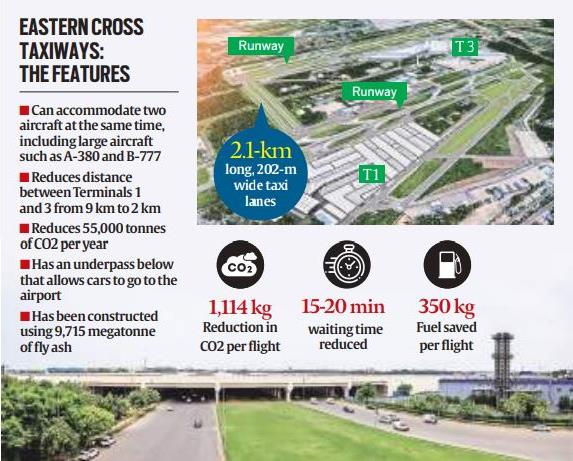Stay updated with the latest - Click here to follow us on Instagram
Delhi Airport to launch first-of-its-kind dual elevated taxiway
The two taxiways will be separated by a 47-m-wide gap, which will allow safe simultaneous passage. There will also be carriageways on both ends to allow emergency vehicles to move.
 The goal of the ECT is to not only to reduce waiting time for passengers but also cut down on aircraft fuel and emissions and enhance operational efficiency. (Express Archives)
The goal of the ECT is to not only to reduce waiting time for passengers but also cut down on aircraft fuel and emissions and enhance operational efficiency. (Express Archives) The Delhi Airport is set to launch a fourth runway along with a first-of-its-kind dual elevated taxiway that will reduce time spent on the tarmac by flyers before take-off and after landing by 15-20 minutes. While the runway will be inaugurated on July 13, the date of operation for the elevated taxiway is to be decided later.
According to sources from the Delhi International Airport Limited (DIAL), the Eastern Cross Taxiways (ECT) will connect the northern and southern airfields and reduce taxi distance for aircraft by 7 km. It will be 2.1-km long and 202-m wide. The ECT will be wide enough to accommodate two aircraft at the same time, including big aircraft such as A-380 and B-777.

The two taxiways will be separated by a 47-m-wide gap, which will allow safe simultaneous passage. There will also be carriageways on both ends to allow emergency vehicles to move.
The goal of the ECT is to not only to reduce waiting time for passengers but also cut down on aircraft fuel and emissions and enhance operational efficiency. The ECT would lead to 350 kg of fuel and 1,114 kg of CO2 saved per flight, said a DIAL official. This will result in 55,000 tonnes of CO2 saved per year.
Currently the airport’s Terminals 1 and 3 are 9 km away which compels aircraft to take a long roundabout route from one terminal to another. The ECT will reduce this distance between them to 2 km.
The elevated taxiway will form an underpass through which cars can access Terminal 3 from Mahipalpur through the Central Spine Road.
The ECT was constructed under the Phase 3A Expansion Works project, whose contract was awarded to Larsen and Toubro (L&T) in 2019. L&T has also worked on the newest fourth runway.
A GMR whitepaper on the project mentions that the elevated taxiway has 590 girders — each weighing 90 metric tonnes — that are capable of withstanding TNT or RDX explosions and earthquakes. 9,715 metric tonnes of industrial fly-ash was used in its construction.
Speaking on the occasion, Deputy Managing Director of GMR Group I Prabhakara Rao said, “This historic feat is a testimonial to DIAL’s commitment to creating environmentally sustainable architecture and becoming a ‘Net Zero Carbon Emissions Airport’. With the Eastern Cross Taxiway, the Delhi airport has… not only enhanced passenger experience but also made Delhi airport future-ready.”







